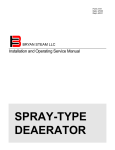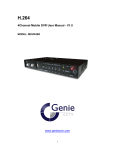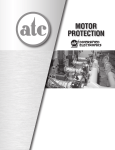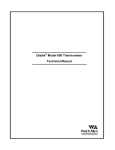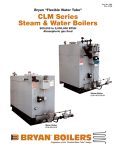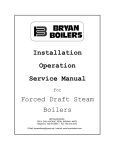Download Bryan Boilers A-H-FS-15-12-50-D operati Service manual
Transcript
Form 2143 Date: 4/3/03 Repl: 2/1/99 BRYAN STEAM LLC Installation and Operating Service Manual BOILER FEED SYSTEM 0 INSTALLATION AND OPERATION SERVICE MANUAL BOILER FEED SYSTEM Bryan Steam LLC 783 North Chili Avenue * Peru, IN 46970 Phone 765.473.6651 • Fax 765.473.3074 E-mail: [email protected] Internet: www.bryanboilers.com MODEL IDENTIFICATION & DESIGNATION Boiler Feed System A – H - FS – 15 – 12 – 50 – D A = LINING BLANK – NO LINING A – APEXIOR LINING B – GALVANIZED LINING H = TANK POSITION H – HORIZONTAL TANK POSITION V – VERTICAL TANK POSITION C - COMPACT FS = FEED SYSTEM (TS – TRANSFER SYSTEM) “15” = BOILER RELIEF VALVE SETTING “12” = MAX. BOILER HP “50” = TANK SIZE (GALLONS) “D” = NO. OF PUMPS S – SIMPLEX PUMPS D – DUPLEX (2) PUMPS T – TRIPLEX (3) PUMPS Q – QUADRAPLEX (4) PUMPS Table of Contents SECTION 1 – INSTALLATION INSTRUCTIONS 1.1 FOUNDATION ......................................................................................................... 1 1.2 CLEARANCE ........................................................................................................... 1 1.3 UNCRATING THE FEED SYSTEM ........................................................................... 2 1.4 BOILER FEED SYSTEM CONNECTIONS ................................................................. 2-3 1.5 FEED SYSTEM ACCESSORY EQUIPMENT.............................................................. 4-5 1.6 PROCEDURES TO BE FOLLOWED BEFORE PLACING FEED SYSTEM IN OPERATION............................................................................... 5 SECTION 2 – START – UP 2.1 LIMIT TEST ............................................................................................................ 6-7 2.2 OPERATING INSTRUCTIONS ................................................................................. 8 2.3 MAINTENANCE SCHEDULE ................................................................................... 8 SECTION 3 – SHUTDOWN AND 3.1 RE-START REQUIRED PRECAUTIONS DURING TEMPORARY USE........................................ 9-10 3.2 CLEANING THE BOILER AND SYSTEM – NEW SYSTEMS ..................................... 10 3.3 SYSTEM CLEAN – OUT........................................................................................... 10 3.4 REPLACEMENT BOILER SYSTEM INSTALLATION: PROTECTION AGAINST CORROSION & SEDIMENT .............................................. 10-11 3.5 BOILER WATER TREATMENT ................................................................................ 11 3.6 SUGGESTED MAINTENANCE SCHEDULE .............................................................. 12 3.7 IDLE BOILER SYSTEMS CARE & LAY-UP .............................................................. 12-13 B O I L E R F E E D S Y S T E M D A T E : 4 / 3 / 0 3 R E P : 2 / 1 / 9 9 1 Section Installation Instructions – Boiler Feed System Note: Please read the entire instruction manual before attempting installation. Insurance and local or state regulatory codes may contain additional or more stringent requirements than those contained in this manual. Installation must conform to these codes and any other authority having jurisdiction. Appropriate sections of the National Electric Code and ASME Code should be consulted and followed. 1.1 FOUNDATION Before uncrating, the location should be prepared. The boiler feed system should set upon a good level concrete floor. If the unit is not level or the floor is not in good condition, a concrete foundation should be built, the dimensions being larger than the outside dimensions of the boiler feed system base. 1.2 CLEARANCES NOTE Adhere to all applicable local codes and NEC regarding system feed system installation and clearances. The unit may need room for service accessibility and clearances for piping and electrical connections. Local codes must be applied to specific installations and the minimum clearances established accordingly. If an electrical panel is supplied, the NEC requires a 36” service entrance in front of the electrical panel. 1.3 UNCRATING THE BOILER FEED SYSTEM Leave the packaging material used for crating in place until ready for installation. The crating is not designed for outdoor storage; therefore the unit should be stored inside. Uncrate the boiler 1 B O I L E R F E E D S Y S T E M D A T E : 4 / 3 / 0 3 R E P : 2 / 1 / 9 9 feed system near its permanent location. Before installation, take inventory of items that were shipped loose so they will not be misplaced. 1.4 BOILER FEED SYSTEM CONNECTIONS 1.4.1 GENERAL Maintain clearances as shown on the dimensional drawing for servicing and as referenced in N.E.C. All piping should be designed and installed to avoid any loadings on the feed system connections or piping. Install pump discharge piping so that accessibility and maintenance on the pumps can be done with ease and that pumps can be removed for service if required. 1.4.2 MANUAL MAKE UP WATER CONNECTION There are two connections supplied for make-up water on the HFS system and one connection on the CFS model. A manual fill connection (top center) is supplied for a by-pass around the standard make-up water connection (HFS only). The standard make up water connection is located on the side of the unit and is tied in directly with a level control to maintain minimum level of water in the vessel. 1.4.3 CONDENSATE RETURN CONNECTION The condensate return connection is located on top of the tank. All condensate returns should be piped to this connection for entrance into the feed system. Since this vessel is an atmospheric tank the condensate returns coming back should be of low pressure and will be introduced to atmospheric conditions once entering the tank. If high-pressure returns are required to return to this tank, they should be reduced to a low pressure before entrance. A steam pre-heater assembly (optional) may have been supplied with the unit. This connection is for high-pressure steam and is reduced and controlled via a pressure/temperature regulating valve and enters the tank through a sparge tube. This has been sized based on specific conditions given at the time of ordering. For proper operation and maintenance of the valve and proper installation, please reference the valve manufacturer’s instructions supplied with the unit. This connection is used to preheat the water in the tank and is controlled based on a temperature pilot, with the sensor located in the tank. 1.4.4 VENT CONNECTIONS There are two vent connections supplied on the HFS unit and one on the CFS unit that should not be reduced. One is a 3” vent connection and the other is labeled “blowout opening” on the HFS model only. The tank vent connection must be vented to the atmosphere and piped to a safe discharge location for hot temperatures. The blowout opening is designed as an additional safety condition against having pressure in the tank. The blowout opening has a neoprene rubber stopper installed so if pressure is built up in the tank, the stopper will blow out of the connection relieving the pressure in the tank. NOTE: The tank should never, under any circumstances, be installed to become pressurized. 2 B O I L E R F E E D S Y S T E M D A T E : 4 / 3 / 0 3 R E P : 2 / 1 / 9 9 1.4.5 OVERFLOW CONNECTION The overflow connection should be piped to an approved drain for gravity flow of any water that may reach that level in the tank. The purpose of the overflow connection is to keep the tank from being flooded in case a high level condition occurs in the unit. If a feed system is used in proper operation, the overflow should not need a trap or any valve for proper discharge of the water into an atmospheric drain. 1.4.6-A PUMP CONNECTIONS HFS/HTS: The pump(s) suction piping should already be installed on the feed system from the factory. This would include a gate valve and strainer for each pump and unions installed in order to remove or replace the pump if necessary. Pump bypass connections are also located on the bottom of the tank. These connections are used (when necessary) in conjunction with the pump discharge in order to bypass flow back to the tank when the pump GPM flow exceeds the flow required by the boiler. These connections are typically used to help keep the flow rate on the operating curve of the pump and to help introduce water into the boiler at a more reasonable rate. However, these connections may not be necessary depending on the system design. A stop valve and check valve should always be installed as close to the boiler inlet as possible. CFS: The pump is a tank mounted pump mounted directly on the top of the tank. The pump wetted parts are submerged in the tank with suction no less than 2” from the bottom of the tank. The pump suction has a screen to protect the pump from debris. This screen will need cleaned periodically for proper pump operation. A throttling valve may be required in the pump discharge piping to keep the pump on its operating curve. A stop and check valve should always be installed as close to the boiler inlet as possible. 1.4.7 ELECTRICAL CONNECTIONS All electrical connections must conform to the NEC and to all other applicable State and Local Codes. Wiring to the main power terminals in the control panel (if supplied) by the contractor must have current carrying capacity equal to at least 125% of the amperage rating of the boiler feed system. Pump motors supplied are multi-tapped motors and the wiring in the motors should be checked to make sure it matches the voltage being supplied. If wiring was done at the factory, the wiring diagram will be supplied with the boiler feed system. The power supply voltage must be as shown on the wiring diagram enclosed. Caution: All control panels and controls are subject to some internal heat. Adequate boiler room ventilation must be provided. 1.5 BOILER FEED SYSTEM ACCESSORY EQUIPMENT 1.5.1 GENERAL The boiler feed system equipment list supplied with this manual lists the components supplied with the unit. Detailed information can be found in the manufacturers literature supplied. A description of the major components follows: 3 B O I L E R F E E D S Y S T E M D A T E : 4 / 3 / 0 3 R E P : 2 / 1 / 9 9 1.5.2 MAKE UP FILL VALVE A self-contained mechanical float type make up water control is proved to accept incoming water up to a differential pressure of 70 psi (see manufacturer’s date for exact pressures). The make up valve assembly mounts directly into the tank to eliminate unnecessary external piping and can be removed from the outside of the vessel for easy maintenance and inspection. The valve is made of brass or bronze with a copper float that does not require any external power for operation. Optional fill valves may have been supplied with your unit. Please check the specific manufacturer’s literature for the operation of this valve. 1.5.3 PUMPS There are two different designs used as standard pumps on Bryan HFS and VFS Feed systems. Horizontal turbine pumps are used primarily for the smaller sized units and vertically centrifugal pumps are used primarily for the larger units. The Bryan CFS feed system utilizes a vertical centrifugal pump that is mounted directly on top of the tank. Please follow the specific manufacturer’s literature for operation and start up of these pumps. It may affect your warranty and the operability of your pump is specific instructions are not followed. Pumps are sized based on approximately two times the boiler evaporation rate of the horsepower shown in the model number and on a maximum feed water temperature of 200 degrees F. Some pumps may need by-pass piping or a throttling valve in the discharge line to keep the pump flow at a satisfactory level on the pump curve. All pump motors supplied are multi-tapped. Therefore, before supplying power to the pumps, make sure the motor is wired for the voltage being supplied. 1.5.4 STEAM PRE-HEATER ASSEMBLY (OPT) A steam pre-heater assembly may have been provided with the boiler feed system. The assembly includes a combination pressure/temperature regulating valve, stainless steel sparge tube, “y” type strainer, and steam valve. The pressure/temperature regulating valve eliminates the need for a separate pressure regulator and a temperature regulator. Normal operation is controlled by the temperature pilot, and the pressure pilot sets an upper limit on the downstream steam pressure. The regulator is a pilot actuated, diaphragm-operated type with a separate pressure and temperature pilot. The valve is sized based on 100% make-up water being raised 140 degrees F. The stainless steel sparge tube is supplied to reduce noise and the piping and valves are sized based on maximum steam velocity of 7000 ft/min. The valves come shipped loose and proper installation is required for efficient use. 1.5.5 OTHER OPTIONS Additional items may have been supplied with your feed system and can be referenced on the equipment list, wiring diagram, and/or dimensional supplied with this manual. If available, the manufacturer’s literature data is supplied with this manual for proper installation and maintenance. Please consult factory if additional information is required. 4 B O I L E R F E E D S Y S T E M D A T E : 4 / 3 / 0 3 R E P : 2 / 1 / 9 9 1.6 PROCEDURE TO BE FOLLOWED BEFORE PLACING BOILER FEED SYSTEM IN OPERATION 1.6.1 CLEANING THE FEED SYSTEM After installation is complete, the feed system should be checked for debris. Any debris found in the tank, pump, or strainers should be removed before start-up. Mechanical floats should be checked to make sure no debris is keeping the float from operating correctly. If a steam preheater assembly as supplied, the pressure/temperature-regulating valve should also be checked for obstructions. 1.6.2 LEAK TEST OF FEED SYSTEM AND PIPING After completing the feed system installation, the piping connections, fittings, attachments and adjacent piping must be inspected for leaks by filling the unit with water. Inspect all openings and fittings for leaks, removing any obstructions if necessary for proper evaluation. Although the feed system is inspected and tested at the factory, minor leaks in fittings and attachments can develop from shipping vibrations or from installation procedures. It may be necessary to re-tighten such fittings after installation and after the boiler feed system has been in operation for some time. 5 B O I L E R F E E D S Y S T E M D A T E : 4 / 3 / 0 3 R E P : 2 / 1 / 9 9 2 Section START-UP AND OPERATION – BOILER FEED SYSTEM WARNING: IMPROPER SERVICING AND START-UP OF THIS EQUIPMENT MAY CREATE A POTENTIAL HAZARD TO EQUIPMENT AND TO OPERATORS OR PERSONS IN THE BUILDING. SERVICING AND START-UP MUST BE DONE ONLY BY FULLY TRAINED AND QUALIFIED PERSONNEL. CAUTION: BEFORE DISCONNECTING OR OPENING ANY FEED SYSTEM ITEMS OR ACCESSORIES, OR BEFORE CLEANING OR REPLACING PARTS OF ANY KIND TAKE THE FOLLOWING PRECAUTIONS: • • • Turn OFF and lockout all electrical disconnects to the feed system and any other equipment or systems electrically interlocked with the unit. All cover plates, enclosures, and guards must be in place at all times except during maintenance and servicing. Close all valves to stop any water or steam from entering the feed system during maintenance or servicing OPTIONAL CONTROLS MAY HAVE BEEN SUPPLIED WITH THIS UNIT THAT ARE NOT ADDRESSED IN THIS SECTION. PLEASE REFER TO THE FEED SYSTEM EQUIPMENT LIST, DIMENSIONAL, AND/OR ELECTRICAL DIAGRAM FOR THEIR PURPOSE AND THEIR MANUFACTURER’S LITERATURE FOR PROPER TESTING PROCEDURES. 2.1 LIMIT TEST 2.1.1 PROTECTIVE DEVICES All operating and limit controls, and low water cutoffs must be tested for proper operation before start-up. 6 B O I L E R F E E D S Y S T E M D A T E : 4 / 3 / 0 3 R E P : 2 / 1 / 9 9 2.1.2 ATMOSPHERIC TANK DESIGN This tank was designed to be used only in atmospheric conditions. To avoid potential hazards, this tank should never be pressurized. Safety precautions should be taken to make sure the tank is never pressurized. 2.1.3 LOW WATER CONDITION (A low water cutout is not supplied as standard on the boiler feed system, although it may have been supplied as an optional item.) Under normal operating conditions, the tank should never be allowed to be in a low water condition. If the water level falls in the tank, the make-up valve should open to satisfy the demand for water. The valve is efficiently sized to maintain the water level based on the maximum horsepower of the unit. If the low water control or probe was supplied, it should be checked to make sure the pump circuit will de-energize on a low water condition and an alarm condition occurs. When the water level has been increased above the low water control, the pump should operate normally. 2.1.4 FEED WATER CONTROL ON THE BOILER The feed pump supplied with this unit should be electrically wired to the level control mounted on the boiler so that the boiler will maintain proper water level. Please reference the wiring diagram supplied with the manual for proper wiring. This connection should be checked before putting the boiler into operation, making sure that it is operating correctly. 2.1.5 BOILER FEED PUMP The start-up procedures found in the boiler feed pump manufacturer’s data should be followed very carefully and may include venting the pump before actual operation. Failure to follow the manufacturer’s recommendations may void the warranty of the pump and also keep the pump from operating correctly. The boiler feed pump must also be operationally tested to assure that it provides boiler feed water at the pressure and in the amount needed for safe and reliable boiler operation. The feed pump should be capable of supplying water to the boiler at least 3% above the boiler relief valve setting. A throttling valve may be required in the discharge line to keep the pump on the operating curve. 2.1.6 OTHER CONTROLS Additional controls, as required for a particular system, may also be provided. Refer to the literature on these devices included in the feed system manual. All such devices must be operationally tested to assure reliable operation of the boiler and system. 2.1.7 CHEMICAL FEED SYSTEM & SOFTENER Check the performance of the boiler water softener and chemical treatment system. Chemically test the feed water to be certain it complies with the recommendations of the chemical treatment consultant. 7 B O I L E R F E E D S Y S T E M D A T E : 4 / 3 / 0 3 R E P : 2 / 1 / 9 9 2.2 OPERATING INSTRUCTIONS CAUTION: Check all electrical terminals and piping connections for tightness before start-up. 2.2.1 FAMILIARIZATION WITH MANUAL(S) The user of the feed system and boiler system must familiarize himself with this manual to be sure he is prepared to operate and maintain the system properly. The operating instructions should be kept in a safe place and available to all who may be working or operating the feed system. READ THE MANUAL BEFORE ATTEMPTING A START-UP 2.2.2 TURNING THE SYSTEM ON Make sure all valves are open that need to be open to the feed system in order to operate the feed system. The tank should fill up to half full with make-up water and the valves to the pumps on the suction end discharge side should also be opened and the strainers should be clean. The pump should have been vented (if required) and all other instructions followed in this manual and also in the manufacturer’s data manuals for each particular item supplied. When the tank has been filled to at least half full and all other instructions followed, the feed system is ready for operation. Power may be turned on to the system for operation. The boiler should also be checked to make sure it is ready to receive water and is working properly. 2.3 MAINTENANCE SCHEDULE Post a maintenance schedule in accordance with the recommendations in this manual. A typical schedule is included in this manual. 8 B O I L E R F E E D S Y S T E M D A T E : 4 / 3 / 0 3 R E P : 2 / 1 / 9 9 3 Section CARE AND MAINTENANCE BOILER FEED SYSTEMS 3.1 REQUIRED PRECAUTIONS DURING TEMPORARY USE 3.1.1 GENERAL A boiler system is often utilized in new construction to assist in curing of building components or to provide temporary heat or for other purposes. If precautions are not taken during this time to protect the boiler system, a great deal of damage can occur before the ultimate owner takes over the building. It is the mutual responsibility of the installing contractor and the boiler owner to consider the effect of temporary usage on the boiler system warranty. The following should be observed so as to assure the longevity of the feed system. 3.1.2 OPERATOR SKILLS/RESPONSIBILITIES During the temporary use period, a single person must be assigned responsibility for the care and operation of the boiler feed system. This person’s responsibility must include, but not be limited to, the following: 1. Knowledge of boiler system operation. 2. Possession and understanding of boiler system operating instruction manuals. 3. Assurance that the boiler system is fed with only treated water at all times and that chemical treatment and blowdown procedures are always followed. 4. Notification to the manufacturer (or manufacturer’s agent) to provide start-up services if the feed system was purchased with start-up by a factory representative. 5. Adherence to all of the start-up procedures noted in the manuals. 9 B O I L E R F E E D S Y S T E M D A T E : 4 / 3 / 0 3 R E P : 2 / 1 / 9 9 6. Considerations of warranty should the boiler system be used for temporary heat without adherence to the recommended start-up and operating procedures outlined in the instruction manuals. 3.2 CLEANING THE BOILER AND SYSTEM – NEW SYSTEMS BOIL OUT PROCEDURE The internal surfaces of a newly installed boiler will have oil, grease, or other protective coatings used in manufacturing. Such coatings must be removed since these coatings lower the heat transfer rate and reduce operating efficiency. The operator must be familiar with the procedure outlined in the boiler/burner operating instruction manuals. In combination with system contamination, bacteria may cause objectionable odors, sometimes resembling natural gas. It is important to keep these fumes from air intake that would distribute them throughout the building. On steam humidification systems this is especially critical. Consult your local water treatment chemist for further information. Your water consultant or water treatment company will be able to recommend a cleaning or boil out procedure. 3.3 SYSTEM CLEAN OUT Many boilers have been ruined with system contaminants such as pipe dope, cutting oil, metal shavings or chips, and other debris that are left in the piping. SYSTEM CLEANING PROCEDURE For steam systems, the boiler will need to be connected to the header utilizing steam to purge the piping and thus push the debris out of the system. However, at this time, all condensate must be wasted until it runs clear and water analysis of the condensate indicates that it is free of contaminants. Steam trap strainers must be periodically opened and cleaned of any debris that accumulates. During this system clean out, the boiler make-up water must be properly softened and treated. At the conclusion of the system clean out, the condensate must be reconnected. For existing steam systems, the installation process may have jarred debris loose. Following the boil out of the new boiler, the condensate should be wasted until it is within proper guidelines. Check all steam trap strainers to assure their cleanliness. 3.4 REPLACEMENT BOILER INSTALLATIONS: PROTECTION AGAINST CORROSION & SEDIMENT CLEAN OR REPLACE ALL SYSTEM PIPING AND HEATING UNITS Arrange for chemical or mechanical cleaning of the entire system. A chemical treatment company should be consulted for the proper means of any chemical cleaning. Replace any piping considered to be deteriorated beyond safe or cleanable condition. Flush the system clean, being certain to isolate the boiler. DO NOT FLUSH THE SYSTEM THROUGH THE BOILER. 10 B O I L E R F E E D S Y S T E M D A T E : 4 / 3 / 0 3 R E P : 2 / 1 / 9 9 FILTRATION For some old systems, there is a reluctance to clean the piping because of the possibility of leaks occurring in badly corroded lines. Should the customer refuse cleaning, it is necessary to install filtration equipment. Install either a fibrous filter or a centrifugal filter in the boiler return piping. This will collect and remove sediment from the system. A booster pump may have to be installed as well to overcome the additional pressure drop introduced in the line by the filter. When filling the system, provide chemical treatment as outlined in Section 3.5. CAUTION Failure to properly clean the system or to install mechanical sediment removal equipment can result in pipe blockage and severe corrosion plus damage to pumps, controls, and air removal devices. 3.5 BOILER WATER TREATMENT PURPOSE OF WATER TREATMENT Water treatment is required for satisfactory operation of the boiler system. It must be devised to prevent depositing of scale and corrosion and other such harmful elements that may be in the water supply. A qualified water treatment chemist should be consulted and the water systematically treated. OBJECTIVES The basic objectives of water treatment are: Prevent the accumulation of scale and deposits in the boiler system. Protect the boiler against corrosion. Maintain the highest possible boiler efficiency. Decrease the amount of boiler system down time from cleaning. CONTINUOUS MONITORING REQUIRED Water treatment should be checked and maintained whenever the boiler is operating. The boiler operator should be sure that the boiler is not operating for long periods without proper water treatment. Water treatment may vary from season to season or over a period of time. Therefore, the water treatment procedure should be checked not less than four times a year, and possibly more frequently as the local water conditions may indicate. All water introduced into the boiler system should be softened and should include an oxygen removal system. This is required to remove dissolved oxygen from the water. Dissolved oxygen can cause severe corrosion in the heating system. DRAINING AND REFILLING THE BOILER & SYSTEM If the system is drained and then refilled, chemical treatment is essential to treat the make-up water. Use only clean, softened water 11 B O I L E R F E E D S Y S T E M D A T E : 4 / 3 / 0 3 R E P : 2 / 1 / 9 9 3.6 SUGGESTED MAINTENANCE SCHEDULE DAILY Make visual inspection of gauges, monitors, and indicators and record readings in boiler system log. Make visual check of instrument and equipment settings against factory recommended specifications. Check operation of float controls to ensure proper functioning. The lower piping connections of float type level controls (if external float supplied) should have a suitable blowdown valve piped into a proper discharge station. This valve should be opened periodically to allow any sludge accumulated in the control to be flushed out. Consult manufacturer’s instructions. Check pump operation. See manufacturer’s data for detailed instructions. WEEKLY Confirm boiler room area is free of combustible materials and has no obstructions. Check all limit controls as specified in manufacturer’s manual. Check float low water cutoff as described above. Make sure all fuses are in operating order. MONTHLY Make visual inspection of all wiring and components. Confirm proper pump operation. Check pump strainers for cleanliness. ANNUALLY Check operating control and other electrical components for proper operating procedures as specified in manufacturers instructions. The vessel and piping should be checked annually and the pump(s) inspected thoroughly. An operational test should be performed and system checked as in start-up procedures before staring the new heating season. 3.7 IDLE BOILER CARE AND LAY-UP GENERAL Corrosion damage to boilers is often the result of improper lay-up during non-operating periods. Substantial damage can occur in only a few days if proper precautions are not taken. This damage is irreversible and will reduce boiler reliability, increase maintenance costs and eventually shorten the useful life of the boiler system. 12 B O I L E R F E E D S Y S T E M D A T E : 4 / 3 / 0 3 R E P : 2 / 1 / 9 9 Idle boilers are vulnerable to attack when air contacts untreated wet metal surfaces. To prevent corrosion, the metal must be protected by either keeping the surfaces completely dry or by excluding air from the system. PRE-OPERATIONAL CLEANING AND LAY-UP Proper lay-up techniques must be used on an idle system even if it has never been in operation. Before pre-operational lay-up, the boiler system must be chemically cleaned as outlined in Section 3.2 and 3.3 of this manual. This is required, as noted in this section, to remove preservatives, oil and grease. LAY-UP CONSIDERATIONS There are two basic methods of steam boiler lay-up; Wet lay-up and Dry lay-up. The method used depends on: The possibility that the boiler may need to be placed in operation on short notice. Disposal of lay-up solutions. Freezing potential. Wet Lay-up is recommended for relatively short outages, such as seasonal lay-up. This method has the advantage of allowing the boiler to be brought on line with short notice. It can pose problems if there is any likelihood of freezing. Dry lay-up is recommended for longer periods of boiler shutdown or storage. It is practical only if the boiler system can be drained hot (1200F to 1700F) or if external drying can be provided. 13

















